According to a new analysis using the revised characteristics, the objects Kepler-854b, Kepler-840b and Kepler-699b are no longer considered exoplanets. According to scientists, their size is too large for the planets. Most likely, these objects are just little stars. The fourth object, Kepler-747b, is questionable. More information may be needed to pinpoint it.

Meanwhile, to date, astronomers have confirmed more than 5,000 exoplanets. And only in three cases they turned out to be wrong. This testifies to the incredible accuracy in determining exoplanets with existing instruments with an error of 0.06%. It also means that scientists will be able to be more confident in diagnoses of exoplanets in the future.
The boundaries between the masses of the planets and the stars may be a little blurred. But those borders do exist. Below a certain limit, objects become too small to create the pressure and temperature in the nucleus needed to ignite the hydrogen fusion that feeds the star. They become planets like hot Jupiters. Above a certain limit, an object is born a star.”Most of the discovered exoplanets are the size of Jupiter. An object twice the size of Jupiter already is doubted to be a planet. Most likely, it’s a star”, — explains Prajval Niraula, an astronomer and project manager of the Massachusetts Institute of Technology.
Error detection
As tools and methods for detecting exoplanets improved, scientists began to use the so-called phase curve. It includes light from the stars, which the exoplanet reflects as it orbits. This method provides more information about the object orbiting the star.

Initially, Niraula and his team studied the phase curves to find exoplanets that were lemon-shaped due to gravitational interaction with the parent star. This deformation can give an idea of how massive the objects are. It can also be used to determine whether a two-body system consists of a star and an exoplanet or a star and a smaller star.
In 2016, Kepler-854b was discovered as an exoplanet. At that time, the tools did not allow us to designate objects accurately. A re-study of Kepler-854b in 2021 gave us the first hint that something was wrong.”Suddenly we acquired an instrument that provided this ellipsoidal signal, which was really convincing. Almost immediately, we realized that the object could not be a planet”, — said Avi Shporer, an astrophysicist of the Kavli Institute for Astrophysics and Space Research at the Massachusetts Institute of Technology.
Checking with Gaia
When Niraula and his colleagues reviewed the properties of Kepler-854b with the Gaia Observatory, they found that the exoplanet was much larger than expected — about three times larger than Jupiter. They also calculated its mass, which was 239 times greater than Jupiter’s. The upper limit of the planet’s mass is almost ten Jupiters.
“The universe cannot create a planet of this size”, — Sporer explained.
The scientists then re-examined the entire Kepler telescope database and re-examined it through Gaia. It turned out that Kepler-840b is 2.5 times larger than Jupiter, and Kepler-699b — 2.76 times. Only Kepler-747b is in doubt — it is 1.84 times larger than the gas giant. Recall that the size is more than twice the size of Jupiter is suspicious.
The study is published in The Astronomical Journal.
We should remind that earlier one more exoplanet was found orbiting around the nearest star to the Sun.
